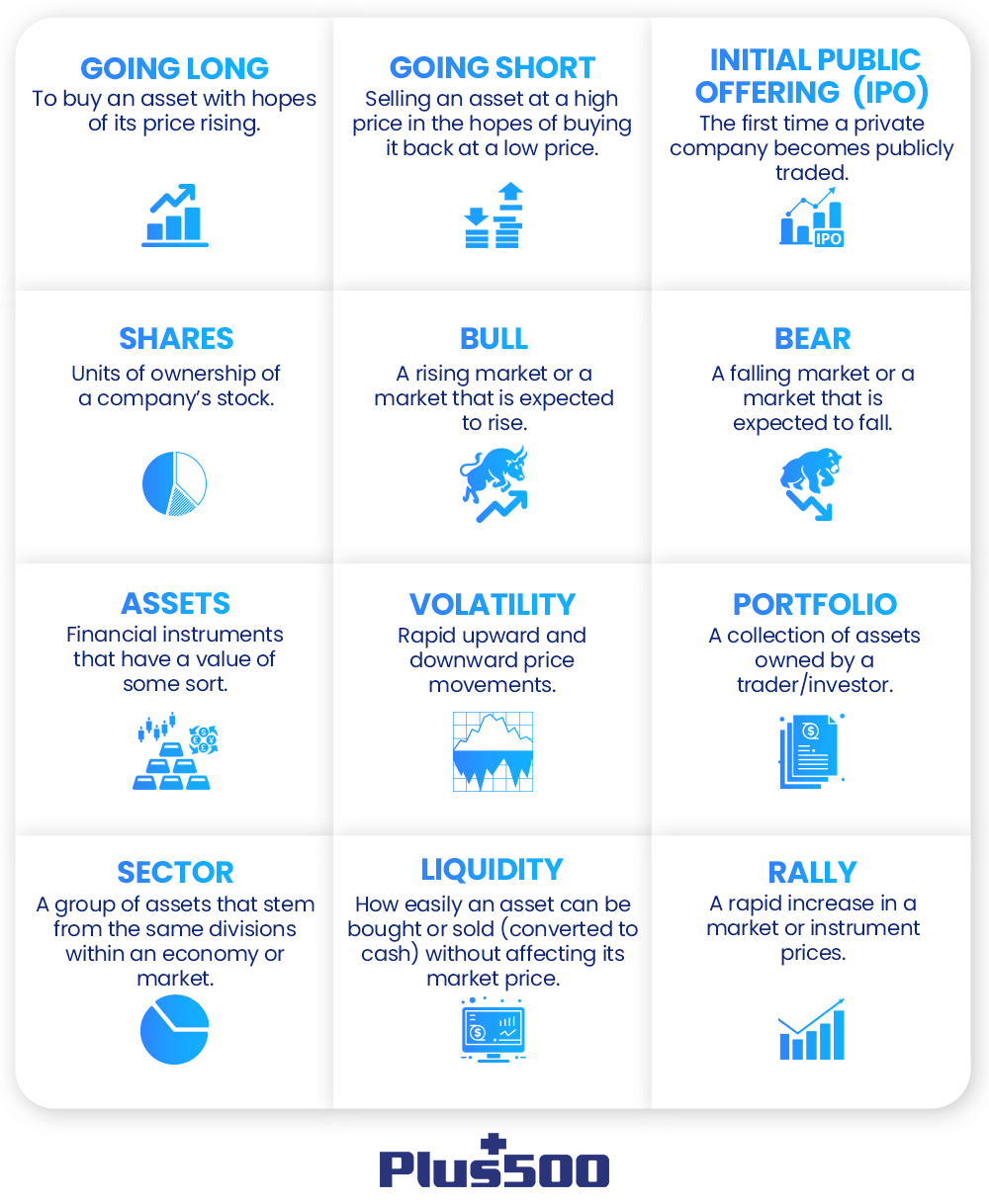Trading Terms Glossary for Beginners
Trading can certainly be an intriguing concept to many, however, in order to really understand how it works, it is crucial to understand the language and terminology used in trading.
This beginner's guide lists some of the main trading terms to help new traders navigate the markets more easily and with confidence. And, to make it easier for you, we have also divided the terms into relevant subcategories. Here is the trading glossary you should keep in mind:

Glossary of Basic Trading Terms for Beginners
Here are some of the most used and basic trading terms that are a must-know for those interested in pursuing trading or for beginners:
- Assets: Assets or trading assets refer to certain financial instruments that have an economic worth of some sort. This can range from Forex to Indices, and Commodities to Stocks, among other types.
- Bid: refers to the highest price a trader is willing to pay in order to purchase a certain market asset.
- Price Quote: A price quote is essentially the price given to a certain stock or security on an exchange.
- Market Order: A market order simply refers to the buying or selling of a certain security immediately at the current market price.
Trading Strategy Terms
Beyond the basic terms, it may be interesting to note that there are different types of trading strategies employed by traders depending on their goals. Some of the main ones include the following:
- Long Position: In simple terms, a long position is the opening of a buy position on a certain market asset.
- Short Position: A short position refers to opening a sell position on a particular asset.
- Swing Trading: This refers to a market strategy that attempts to benefit from assets’ rising or falling prices (price swings) from one day up to several weeks.
- Day Trading: As the name implies, day trading is the act of buying and selling assets in a short period of time. This can range from a day to minutes and seconds. Moreover, the most popular market for day trading is the Forex market.
- Position Trading: This refers to a more long-term trading approach whereby traders keep a certain position open for a longer period of time in order to achieve a profit. The timing can span between weeks to months and more.
- Trend Trading: Trend trading utilizes price chart trends and recurring movements in order to analyze the assets’ overall direction. As such, trend traders can either potentially benefit from upward or downward price movements.
In addition to the above-mentioned terminology, beginners should bear in mind that trading analysis can be a helpful tool and a crucial part of the overall trading process.
As such, there are two main types of trading analysis beginners should be familiar with: Fundamental Analysis and Technical Analysis, and each type has its own vocabulary.
Fundamental Analysis Terms
Fundamental analysis is used to determine if a certain asset is overvalued or undervalued. In other words, it evaluates an asset's intrinsic value by taking into account factors such as macroeconomic conditions and more. When it comes to discussing fundamental analysis, some of the main terms that may come to mind are P/E ratio, EPS, dividends, and market cap:
- P/E Ratio: P/E, which is the abbreviation for Price to Earnings, is essentially used as a way to measure whether a company is overvalued or undervalued in relation to the company’s earnings. In other words, it attempts to see if a company’s stock is expensive or cheap.
- EPS: EPS or Earnings Per Share is a measure of a company’s profitability as it takes its profit and divides it by the number of shares outstanding. As such, higher EPS can indicate more profitability and vice versa. To read more about EPS, how it works, and its different types, you can read our “Earnings Per Share (EPS) Defined” article.
- Market Cap: Market capitalization or “market cap” refers to the total value of a publicly traded company’s shares. To gain a better understanding of what market capitalization is, check out our “Market Capitalization Explained” article.
Technical Analysis Terms
This type of analysis uses past price patterns in order to predict future performance. In addition, it uses trading charts like candlesticks and looks at chart patterns in order to gain an overall grasp of the asset’s prices.
While some traders consider technical analysis, it is important to keep in mind that past prices do not indicate future performance. Some of the main terms that can relate to technical analysis include support and resistance levels, trendlines, and moving averages.
- Support Level: Support level refers to the point at which an asset is in high enough demand that it's hard for it to fall more.
- Resistance Level: The resistance level refers to the point at which an asset has a hard time rising further due to strong supply.
- Trendline: Trendlines are lines that show an asset’s certain price trends. These lines can be used in technical analysis in order to help traders assess the maximum highs and lows of a certain asset.
- Moving Average: Moving averages are technical indicators or statistics that help technical analysis traders gauge the direction of a certain asset.
Risk Management Terms
Even the best traders know that trading is accompanied by risks, especially in light of the fact that markets can be unpredictable and volatile. Accordingly, this is where risk management tools come into play.
Risk management is a set of tools used to help traders mitigate risk and some of the most common terms associated with risk management are the following:
- Stop-Loss Order: As the name implies, a stop-loss order is a way for traders to close a position when it reaches a certain price in order to limit losses.
- Limit Order: An order that allows traders to buy or sell an underlying asset when it reaches a certain price.
- Diversification: Sometimes traders add different assets from various sectors to their portfolio in order to mitigate risk and not rely solely on a certain market. This is called diversification.
- Risk-Reward Ratio: The risk-reward ratio is the risk involved in a trade. In other words, it is the measure of the potential profits versus potential risks, and it is used by traders in order to assess potential market profitability. You may learn more about risk-reward ratios in our Trader’s Guide article and video on “Understanding Risk Reward Ratio.”
General Market and Trading Terms
Other general market and trading terms that can be helpful for beginners include the following:
- Bear Market: Bear markets depict a market situation whereby the prices of certain assets fall 20% or more from their recent highs. This fall can be driven by negative market sentiment, economic headwinds, geopolitical tensions, and more.
- Bull Market: Generally speaking, bull markets describe a rise of 20% or more in recent stock market prices. However, this term can sometimes also be used to describe markets that are expected to rise in the future. As such, this type of market condition is accompanied by general optimism about the market's future growth. Bull markets can be driven by general optimism and strong economic conditions among other reasons.
To understand the difference between a bull and a bear market, you can also read our article called “Bull vs Bear Market- What’s the Difference?” - Volatility: Volatility is a must-know term given the fact that it describes the nature of the markets. This term refers to unpredictable and fast market price swings (rising and falling prices).
- Leverage: Leverage allows you to open a position on a certain underlying asset without committing the full amount of money needed to own it. This also means that you can multiply your gains or losses depending on your position.
- Margin: Margin refers to the amount of capital needed to open and maintain a leveraged position. There are different types of trading margins and you can read more about each type in our Trader’s Guide article on “Margin Requirements.”
An Infographic Of the Main Trading Terms
If you are new to trading and would like to memorize some important terms, you can save the following terminology infographic and refer to it for guidance:

Beyond these terms, traders can always refer to Plus500’s Trader’s Guide articles and videos or the free Trading Academy, which delves a bit deeper into some of the most important trading terms. In addition, the internet is a rich resource for information and those interested in trading can use it to their advantage.




